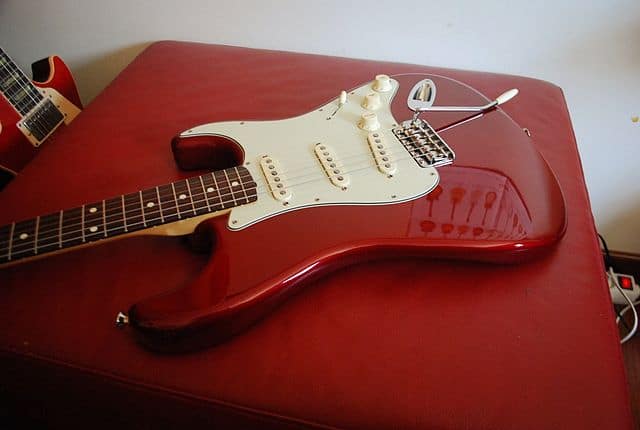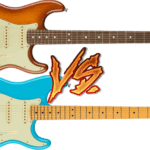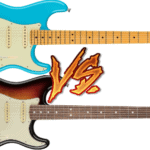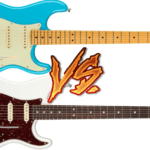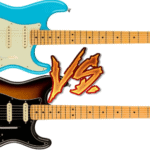The Fender Stratocaster is one of the most popular electric guitars of all time and, arguably, the most versatile electric guitar of all time.
There are a few different models of Strats, each with its own strengths. One of the more subtle spec differences is the number of frets on certain models of Strats.
There is a difference when it comes to 21 and 22 fret Stratocasters but it’s rather subtle and will depend on your style of playing. If you play a lot of lead work, then that extra fret might make a bit of difference. If you play rhythm guitar primarily, then 21 frets will be sufficient.
Modifications are also easier on a 21 fret Stratocaster than they are on a 22 fret Stratocaster.
22 frets are, more or less, the standard across all guitar brands, with some going up to 24 frets, including some Fender guitars.
In the rest of the article, I’ll break down some of the specifics involving the 21 and 22 fret Stratocaster, including the models that have each fret count and how much of a difference each one makes.
I’ll close out by giving my final thoughts on this topic.
Here we go!
Which Stratocaster models come with 21 frets?
These are the only Fender Stratocasters with 21 frets still in production:
- The Standard Stratocaster Made In Mexico
- The American Vintage ’65 Stratocaster
- The Classic Series ’60s Stratocaster
All Fender Stratocasters made before 1987 were designed with 21 frets.
The pre-CBS era (1954-1964) is the most sought-after for vintage guitar collectors, though the price point for them is very high, with many going above $20,000!
The second most sought-after 21-fret Stratocasters are the ones manufactured between 1967 and 1971, an era known as The “Good” CBS Years. These models are also expensive, albeit not as much, ranging between $7,000 and $13,000.
Most Made In Mexico Stratocasters have 21 frets, discontinued and current. The prices for those models are considerably cheaper, usually costing less than $1,000.
I can say from personal experience that a lot of Strat players I’ve come across have Made In Mexico Strats, most of which had 21 frets.
The Fender Vintera Stratocaster seems to also be pretty popular. The Vintera Series Stratocasters are modern Stratocasters built with vintage specs and that includes, you guessed it, the 21 frets.
According to the official Fender website, these are the best selling 21 fret Strats:
- The Jimi Hendrix Stratocaster
- The Stevie Ray Vaughn Stratocaster
- The Dave Murray Stratocaster
Which Stratocaster models come with 22 frets?
The first Fender Stratocaster manufactured with 22 frets is The American Standard Stratocaster – First Series. It was made from late 1986 to May 2000. Ever since then, a majority of Fender Stratocasters made in the USA have been made with 22 frets.
Interestingly, Fender started making 22 fret Stratocasters a year earlier in Japan, with that first model being the Standard Stratocaster (Model #1). This particular model ran from 1985 to October 1987. In my research, Fender Stratocasters Made In japan are often sought-after because of their tone and balance.
The most popular 22-fret Stratocasters are:
- The Fender Player Series Stratocaster
- The Fender American Standard Stratocaster
- The Fender American Professional II Stratocaster
- The Fender American Ultra Stratocaster
Are 21 and 22 fret Stratocaster necks interchangeable?
The cool thing with Fender Stratocasters is that they have bolt-on necks, which enables you to swap out the stock neck and replace it with one of your choosing. So, yes, the 21 and 22 fret necks are interchangeable.
One thing to keep in mind when switching out a 21 fret neck for a 22 fret neck is there’s an overhang where the body meets the neck. The good thing about having this overhang is that it won’t affect your intonation because the scale length isn’t being adjusted.
The only real downside with replacing a 21 fret neck with a 22 fret neck is it becomes a bit trickier to take the pickguard off, should you need to do that at some point to access your pick-ups or to swap out your pickguard.
Is there any difference in tone or playability between 21 and 22 fret strats?
The obvious difference in playability between the 21 and 22 fret Stratocasters is the extra 22nd fret. This extra fret can be beneficial for a lead guitarist to be able to hit that high D (assuming one’s in standard tuning).
Since most guitars are made with 22 frets, some players prefer their Stratocasters to also have 22 frets for consistency when switching between guitars. This way, they can play the same solos with the same amount of frets without having to adjust their playing.
With 21 frets, players might have to bend an extra half step in order to hit the same note that would’ve otherwise taken less of a bend to reach on a 22 fret neck.
Does fret number really matter on a guitar?
To me personally, the fret number does matter depending on which genres you play. It’s most helpful when playing rock and metal solos.
There are some solos that require being able to reach the very high E and it’s made slightly easier to hit with 22 frets than with 21.
I would suggest getting a 24 fret guitar if you want extra frets because it completes the octave up from the 12th fret.
Plus, you can bend the high E at the 24th fret and reach an F# or even a G, notes that are virtually impossible to hit on a 22 fret guitar.
If you’re playing rhythm guitar in just about any genre, most of the time, you won’t need more than 21 frets.
If you’d like more information on this topic, please check out this link:
Should the number of frets be a defining factor when looking for a new strat?
I don’t think the number of frets should be a super important factor when looking for a new Strat.
There are plenty of other features that would be more important to look at when it comes to buying a new Strat, such as pickups and if aesthetics are important to you, the color and fretboard wood.
Even though Stratocasters are very versatile guitars, most people who play Fender Strats don’t play heavier music with lots of solos, so 21 frets are usually sufficient.
If you’re looking for a Strat shape guitar that is more suited for shredding, I’d encourage you to look at Ibanez guitars. They often have 24 frets and are built more for faster solos, with lower action and an accommodating fretboard and neck radius.

Hello there, my name is Ramiro and I’ve been playing guitar for almost 20 years. I’m obsessed with everything gear-related and I thought it might be worth sharing it. From guitars, pedals, amps, and synths to studio gear and production tips, I hope you find what I post here useful, and I’ll try my best to keep it entertaining also.

